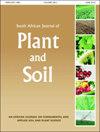Determination of foliar nutrient sufficiency ranges in cultivated rooibos tea using the boundary-line approach
IF 0.7
Q3 AGRONOMY
引用次数: 4
Abstract
Despite the global importance of rooibos tea (Aspalathus linearis (Burm.f.) R.Dahlgren) as a health-promoting crop, foliar nutrient sufficiency ranges have not yet been determined for commercially cultivated rooibos. Determination of these ranges is critical for assessing plant nutrient status and maximising productivity. The aim of this study was to determine optimal rooibos foliar macro- and micronutrient ranges using the boundary-line approach (BLA) method across the main rooibos production areas in South Africa. Foliar nutrient and yield data were collected from 120 different commercial rooibos plantations in the six main rooibos producing areas of the country: Nardouwsberg/ Agterpakhuys, Clanwilliam, Gifberg/ Vanrhynsdorp, Nieuwoudtville, Citrusdal and Sandveld. The BLA-derived optimum (late winter) rooibos foliar macronutrient and 90%-yield sufficiency range concentrations (%) were: 1.55 (1.30–1.80) for N, 0.12 (0.09–0.14) for P, 0.54 (0.34–0.75) for K, 0.20 (0.14–0.26) for Ca, 0.22 (0.19–0.25) for Mg, and 0.10 (0.08–0.11) for S. Optimum micronutrient contents and ranges (mg kg−1) were: 85.8 (57.6–114.1) for Fe, 58.2 (26.9–113.8) for Mn, 16.6 (12.7–20.5) for Zn, 2.8 (1.3–4.2) for Cu, and 26.9 (21.8–32.0) for B. Maintaining foliar nutrient concentrations within these ranges will support maximal yields (1 200 kg ha−1). The foliar nutrient guidelines are of importance for enhancing sustainable rooibos production in South Africa.边界线法测定栽培鲁依波斯茶叶片养分充足度范围
尽管rooibos茶(Asplatus linearis(Burm.f.)R.Dahlgren)作为一种促进健康的作物在全球具有重要意义,但商业种植的rooibos的叶面营养充足范围尚未确定。确定这些范围对于评估植物营养状况和最大限度地提高生产力至关重要。本研究的目的是使用边界线法(BLA)确定南非主要鲁伊博产区的最佳鲁伊博叶片宏观和微量营养素范围。从该国六个主要菜豆产区的120个不同的商业菜豆种植园收集了叶片营养和产量数据:Nardouwsberg/Agterpakhuys、Clanwilliam、Gifberg/Vanrhynsdorp、Nieuwudtville、Citrusdal和Sandveld。BLA得出的最佳(晚冬)菜油叶大量营养素和90%产量充足度范围浓度(%)为:N为1.55(1.30–1.80),P为0.12(0.09–0.14),K为0.54(0.34–0.75),Ca为0.20(0.14–0.26),Mg为0.22(0.19–0.25),S为0.10(0.08–0.11)。最佳微量营养素含量和范围(Mg kg−1)为:Fe为85.8(57.6–114.1),Mn为58.2(26.9–113.8),Zn为16.6(12.7–20.5),Cu为2.8(1.3–4.2),B为26.9(21.8–32.0)。将叶面养分浓度保持在这些范围内将支持最大产量(1200 kg ha−1)。叶面营养指南对提高南非的可持续鲁伊博生产具有重要意义。
本文章由计算机程序翻译,如有差异,请以英文原文为准。
求助全文
约1分钟内获得全文
求助全文
来源期刊

South African Journal of Plant and Soil
Agricultural and Biological Sciences-Plant Science
CiteScore
1.90
自引率
11.10%
发文量
32
期刊介绍:
The Journal has a proud history of publishing quality papers in the fields of applied plant and soil sciences and has, since its inception, recorded a vast body of scientific information with particular reference to South Africa.
 求助内容:
求助内容: 应助结果提醒方式:
应助结果提醒方式:


